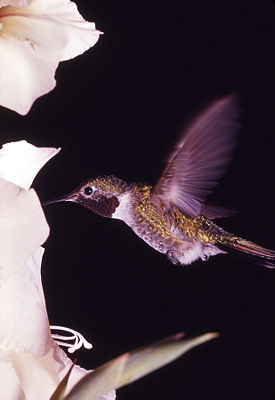Broad-tailed hummingbird
| Broad-tailed hummingbird | ||||||||||
|---|---|---|---|---|---|---|---|---|---|---|

Broad-tailed hummingbird ( Selasphorus platycercus ) |
||||||||||
| Systematics | ||||||||||
|
||||||||||
| Scientific name | ||||||||||
| Selasphorus platycercus | ||||||||||
| ( Swainson , 1827) |
The broad-tailed hummingbird ( Selasphorus platycercus ) or Breitschwanzelfe is an American bird art that within the family of hummingbirds (Trochilidae) to the genus of the North Elves ( Selasphorus belongs).
features
Characteristic for this hummingbird species is a noticeable humming caused by the flapping of the wings. The males differ from the females in the color of the plumage ( sexual dimorphism ). The plumage of the males is red to metallic shimmering in the throat area. The back and the top of the tail are greenish in color. The females are significantly less colorful. They have a white throat and a white color with black spots on the underside of the head. Young males resemble the females in terms of plumage.
The broad-tailed hummingbird reaches a body length between 83 and 97 millimeters and weighs 3 to 4 grams. The wingspan is 12 to 14 centimeters. The males are slightly smaller and lighter than the females.
Way of life
nutrition
The broad-tailed hummingbird feeds on flower nectar and small insects in flight . They mainly attract red flowers with deep openings, such as Ipomopsis aggregata . During the winter, the animals are significantly less picky because otherwise they would not be able to meet their food needs due to the limited supply.
Reproduction
The broad-tailed hummingbird reaches sexual maturity at around one year. The mating season in spring is the only time when both sexual partners come together ( promiscuity ). The male mates with up to six females and is not involved in raising the young.
The nest is built exclusively by the female, in which she lays two eggs. The young hatch after 16 to 19 days. Ten to twelve days later, the female no longer spends the night in the brood nest because it is too small. The young are fledged after about 25 days.
distribution
The breeding areas of the broad-tailed hummingbird are in Nevada , Utah , and Wyoming to east-central California , Arizona , New Mexico , Colorado , and west Texas . The animals also breed in higher regions in Mexico and Guatemala . In autumn, the birds migrate to the highlands of Mexico and in the south to Guatemala to hibernate.
The broad-tailed hummingbird prefers to live in the flowery heathland of the lowlands and regions with pine , juniper , pine , oak , cypress and fir vegetation in higher areas. Some nest at altitudes above 3,000 meters. Many birds have also settled near people.
Etymology and history of research
William Swainson described the broad-tailed elf under the name Trochilus platycercus . The type specimen was collected in Mexico by William Bullock and his son William Bullock Jr. Only later was it added to the genus Selasphorus .
The word Selasphorus is derived from the Greek words "selas σέλας " for "shine, light, flame" and "-phoros, pherō πηοροσ " for "supporting, bearer".
The word »platycercus« is a combination of the Greek words »platus πλάτος « for »broad« and »kerkos κέρκος « for »tail«.
literature
- James A. Jobling: Helm Dictionary of Scientific Bird Names . Christopher Helm, London 2010, ISBN 978-1-4081-2501-4 .
- William Swainson: A Synopsis of the Birds discovered in Mexico by W. Bullock, FLS and HS and Mr. William Bullock, jun. In: The Philosophical magazine: or Annals of chemistry, mathematics, astronomy, natural history and general science. tape 1 , no. 85 , 1827, pp. 433-442 ( online [accessed February 14, 2014]).
Web links
- Selasphorus platycercus inthe IUCN Red List of Threatened Species 2011.2. Listed by: BirdLife International, 2008. Retrieved January 19, 2012.
- BirdLife International: Species Factsheet - Broad-tailed Hummingbird ( Selasphorus platycercus ) . Retrieved January 19, 2012.
- Videos, photos, and sound recordings of Broad-tailed Hummingbird (Selasphorus platycercus) in the Internet Bird Collection
- Broad-tailed elves ( Selasphorus platycercus ) at Avibase; Retrieved January 19, 2012.
- Selasphorus platycercus in the Integrated Taxonomic Information System (ITIS). Retrieved January 19, 2012.
- xeno-canto: Sound recordings - Broad-tailed Hummingbird ( Selasphorus platycercus )
- Selasphorus platycercus on the Animal Diversity Web
- Broad-tailed Hummingbird at All About Birds


